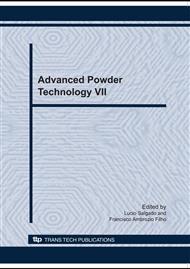p.995
p.1003
p.1009
p.1015
p.1019
p.1025
p.1031
p.1037
p.1043
Comparison of Thermal Analysis, Micro Structural and Compositional of Archeological Indigenous Ceramic (Caninhas Site of Canas - SP) with Actual Clay/Ceramic of Region
Abstract:
The ceramic material found at the archeological site in Caninhas, shows funerary structures of combustion and various objects of Tupi-Guarani indigenous use. These pieces and fragments were saved and cataloged, in approximately 4000 units. The ceramics present a gradient of color, from ochre to dark gray, when from the surface to the center of the piece, indicating compositional variation caused by inefficient sintering carried out by indigenous people. The goal of this study was to observe the phase transition temperature, decomposition, mass variation and reactions that occur in the archeological and nowadays ceramics (by DSC/TG), together with micro structural analysis (by SEM), phase analysis (by XRD) and chemical composition (by EDS). Ceramics nowadays are sintered with air, in a temperature ranging between 400-800 °C for one hour, and presents heterogeneous microstructure. The archeological ceramics were identified by the ilitte, hydrated alumina, lutecite and quartz phase, and the caulinite, lutecite and quartz phase in clay produced today from that region differs in all characteristics and aspects according to time. The interaction between different areas of expertise is fundamental to aggregate knowledge: the use of ceramic material engineering to archeological application.
Info:
Periodical:
Pages:
1019-1024
Citation:
Online since:
October 2010
Price:
Сopyright:
© 2010 Trans Tech Publications Ltd. All Rights Reserved
Share:
Citation:


